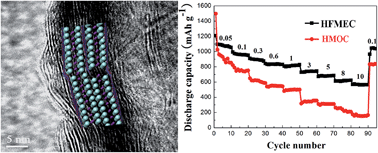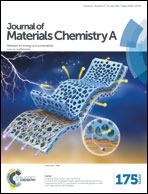High rate lithium-ion batteries from hybrid hollow spheres with a few-layered MoS2-entrapped carbon sheath synthesized by a space-confined reaction†
Abstract
Hybrid hollow spheres with a few-layered MoS2 entrapped carbon sheath (HFMECs) have been successfully synthesized by a 0D spatial confinement approach. In this facile process, a glucose-derived polysaccharide interacted with thiomolybdate on the surface of silica spheres followed by high temperature annealing to form an MoS2–C hybrid sheath. The glucose-derived polysaccharide layers not only serve as a carbon source, but also provide a 0D space-confined nanoreactor to restrict the kinetic growth of MoS2 sheets. When the HFMECs are used as a lithium-ion battery anode, the ultrathin shell (∼12 nm) and few-layered MoS2 nanosheets (≤5 layers) in the hybrid enhance the kinetics of Li+ and electron transport, resulting in excellent rate capability (739, 676, 613 and 563 mA h g−1 at 3, 5, 8 and 10 A g−1, respectively). The hollow structure and high mass content (91 wt%) of MoS2 in the composite guarantee cycle stability and allow for efficient storage (823 mA h g−1 at 1 A g−1 after 200 cycles). The exceptional performance of HFMECs combined with the straightforward approach makes these materials very promising for lithium ion batteries.


 Please wait while we load your content...
Please wait while we load your content...